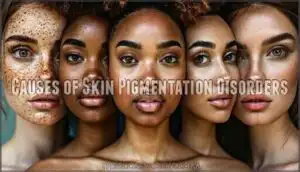This site is supported by our readers. We may earn a commission, at no cost to you, if you purchase through links.
 You’re probably wondering if Olivia Quido’s exfoliating discoloration brightening products actually work, right?
You’re probably wondering if Olivia Quido’s exfoliating discoloration brightening products actually work, right?
This Olivia Quido exfoliating discoloration brightening review shows mixed results that’ll surprise you.
The underarm brightener tackles stubborn dark spots with gentle yet effective ingredients, while the blemish eraser works overtime on facial discoloration.
You’ll notice gradual improvement in skin tone, though it’s not an overnight miracle.
The formula feels lightweight and doesn’t irritate sensitive skin, which is half the battle with brightening products.
Most users see results within four to six weeks of consistent use.
The real game-changer lies in understanding exactly how to maximize these products’ potential.
Table Of Contents
- Key Takeaways
- Understanding Skin Pigmentation
- Addressing Hyperpigmentation
- Exploring Brightening Ingredients
- Reviewing Exfoliation and Discoloration
- Olivia Quido Exfoliating Discoloration Brightening Review
- Frequently Asked Questions (FAQs)
- Can this cream be used during pregnancy?
- Is it safe for daily use on sensitive skin?
- How long to see noticeable results?
- Are there any known side effects?
- Can it be combined with other treatments?
- How long until visible brightening results appear?
- Can pregnant women safely use these products?
- What side effects should users expect initially?
- How does this compare to professional treatments?
- Should other brightening products be avoided together?
- Conclusion
Key Takeaways
- You’ll see gradual skin brightening results within 2-3 weeks of consistent use, with more dramatic improvements in dark spots and discoloration appearing after 4-6 weeks of daily application.
- The lightweight formulas won’t irritate sensitive skin and work effectively across different skin types, though you should patch test first and start slowly to avoid mild initial reactions like redness or tingling.
- You can’t layer multiple brightening products together as this causes irritation, but you can safely combine Olivia Quido treatments with gentle moisturizers and sunscreen for optimal results.
- The underarm brightener targets stubborn dark spots with ingredients like Alpha-Arbutin and 4-Butylresorcinol, while the blemish eraser contains 2% hydroquinone for clinically-proven facial discoloration treatment.
Understanding Skin Pigmentation
You’ve probably noticed how your skin tone can vary across different areas of your body, and that’s largely due to melanin, the pigment that determines your skin’s color and protects you from harmful UV rays.
Understanding how factors like genetics, sun exposure, and hormones affect melanin production helps you make informed decisions about treating common issues like dark spots, uneven tone, and other pigmentation concerns.
Melanin and Its Function
Within your skin, melanin serves as nature’s built-in sunscreen through sophisticated photoprotection mechanisms.
Your skin’s melanin acts as a natural shield, protecting you from UV damage while creating your unique complexion.
This pigment doesn’t just determine your complexion—it’s actively defending you against UV damage and skin cancer.
Melanin synthesis involves complex interactions between genetic factors and hormonal influence, creating your unique skin tone.
While products like Olivia Quido target skin discoloration, understanding melanin’s protective role helps you appreciate why hyperpigmentation occurs.
Here’s what makes melanin essential:
- Melanin types (eumelanin and pheomelanin) create different protective levels and skin tones
- Genetic factors program your baseline melanin production capacity from birth
- Hormonal influence can trigger changes in melanin synthesis, affecting skin pigmentation disorders
Causes of Skin Pigmentation Disorders
Your skin’s pigmentation story unfolds through multiple factors.
Genetic Factors set your baseline melanin production, while Sun Exposure triggers protective darkening responses.
Hormonal Influence from pregnancy or medications can create uneven patches.
Skin Injuries like acne scars often leave lasting marks, and certain Drug Reactions disrupt normal pigment processes.
Understanding these triggers helps you tackle skin pigmentation disorders more effectively.
Types of Skin Pigmentation Disorders
Your skin’s pigmentation story unfolds through distinct disorders that affect melanin production in different ways. Understanding these variations helps you identify what’s happening with your complexion and choose appropriate treatments.
Hypopigmentation Types involve reduced melanin production, creating lighter patches or overall skin tone. Albinism Genetics play a vital role here, where inherited genes prevent normal melanin synthesis, resulting in very pale skin, hair, and eyes.
Hyperpigmentation causes darker spots through increased melanin activity. Common triggers include sun exposure, hormonal changes, and aging. Melasma typically appears during pregnancy or hormone therapy, while vitiligo represents an autoimmune condition where Vitiligo Causes include genetic predisposition and environmental factors.
Darker skin tones may experience post-inflammatory hyperpigmentation after skin inflammation. Drug-Induced Pigmentation and Injury Pigmentation can also alter your skin’s natural color, requiring targeted treatment approaches for effective management.
- Hypopigmentation: Reduced melanin causing lighter skin patches
- Hyperpigmentation: Increased melanin creating darker discoloration
- Albinism: Genetic condition with minimal melanin production
- Vitiligo: Autoimmune disorder causing patchy pigment loss
Addressing Hyperpigmentation
When those stubborn dark spots decide they’re permanent residents on your skin, you’re probably dealing with hyperpigmentation, a common condition where certain areas produce excess melanin.
You’ll find this shows up as age spots, melasma patches, or post-acne marks, but the good news is that targeted treatments like topical creams and specialized ingredients can help restore your skin’s natural balance.
Overview of Hyperpigmentation
Hyperpigmentation occurs when your skin produces too much melanin, creating those stubborn dark patches you’ve probably noticed.
Causes include sun exposure, hormonal shifts, and genetics.
This skin discoloration impacts confidence, but understanding the types helps you choose effective treatment.
Prevention starts with sunscreen, while skin brightening products like olivia quido formulas target exfoliating discoloration for evenness.
Common Conditions: Age Spots, Freckles, Melasma
Three major hyperpigmentation culprits affect your skin differently.
Age spots develop from cumulative sun damage over time, while freckles stem from genetic predisposition plus UV exposure.
Melasma appears when hormonal changes meet sun exposure, creating irregular patches.
Understanding these distinct melasma triggers and age spot causes helps you target the right brightening solutions for your specific concerns.
This condition is worsened by significant sun exposure.
Treatment Options: Topical Creams, Oral Medications
When tackling hyperpigmentation treatment, you’ll find topical creams often deliver solid topical efficacy with fewer oral side-effects than medications.
Prescription requirements vary—hydroquinone needs doctor approval, while niacinamide doesn’t.
Combination therapy works best: pair Olivia Quido exfoliating discoloration products with laser treatments.
Treatment duration spans months, but this brightening review shows consistent results when you stick with your routine.
Daily sunscreen is essential for preventing further damage.
Exploring Brightening Ingredients
You’ve likely heard names like niacinamide and retinol thrown around in skincare conversations, but understanding what these brightening ingredients actually do can help you make smarter product choices.
Modern formulations now include powerhouse ingredients like tranexamic acid and tetrahexyldecyl ascorbate, which work alongside traditional favorites to target stubborn discoloration more effectively than ever before.
Key Ingredients for Brightening
When exploring brightening powerhouses, you’ll discover Modern Actives like tranexamic acid and tetrahexyldecyl ascorbate leading the charge.
These Ingredient Synergies work alongside classics—niacinamide, retinol, and kojic acid—to maximize Topical Efficacy.
You can purchase tranexamic acid serums online.
While Oral Options and Laser Potential exist, these topical ingredients create synergistic effects that combat hyperpigmentation more effectively than single-ingredient approaches.
Skin Benefits of Niacinamide, Retinol, and Kojic Acid
Niacinamide benefits shine in Olivia Quido’s exfoliating discoloration formula, regulating oil and minimizing pores.
Retinol effects accelerate cell renewal, revealing fresher skin beneath dark spots. Kojic acid naturally inhibits melanin formation, preventing new discoloration.
This ingredient synergy creates a powerful product formulation that tackles multiple skin concerns simultaneously. You’ll notice smoother texture and brighter tone within weeks of consistent use.
Many users seek products with niacinamide retinol kojic, looking for complete concepts like niacinamide benefits and retinol effects to improve their skin, with key ingredients working together.
Emphasizing Modern Ingredients: Tranexamic Acid, Tetrahexyldecyl Ascorbate
Two powerhouse ingredients are revolutionizing skin brightening: tranexamic acid and tetrahexyldecyl ascorbate. These modern brightening heroes work together through ingredient synergy, delivering ascorbate efficacy that outperforms traditional treatments.
Tranexamic benefits include blocking melanin pathways, while this stable vitamin C derivative penetrates deeper for lasting results. It’s generally recommended to use vitamin C in the morning and retinol at night for ideal results.
- Tranexamic acid inhibits tyrosinase enzyme activity for targeted pigment correction
- Tetrahexyldecyl ascorbate provides enhanced antioxidant protection with superior stability
- Combined formulations address multiple discoloration pathways simultaneously
- Future research shows promising results within 2-12 weeks of consistent use
Reviewing Exfoliation and Discoloration
You’ve probably noticed that exfoliation plays a vital role in managing stubborn dark spots and uneven skin tone, but understanding how it specifically targets discoloration can help you make smarter skincare choices.
When you combine proper exfoliation techniques with targeted brightening ingredients, you’re basically giving your skin the best chance to shed damaged cells while revealing the healthier, more evenly-toned complexion underneath.
Importance of Exfoliation in Skincare
Exfoliation benefits your skin by accelerating cell turnover and removing dead surface layers that dull your complexion.
Different product types work for various needs—chemical exfoliants like AHAs suit most skin, while sensitive skin requires gentler options.
Regular exfoliating treatment enhances skin brightening results, though environmental impact matters when choosing sustainable formulas for your routine.
Impact on Discoloration and Hyperpigmentation
Regular exfoliation works like a reset button for your skin, helping you tackle stubborn discoloration and hyperpigmentation head-on.
When you remove dead skin cells, you’re creating space for olivia quido exfoliating discoloration treatments to work more effectively. This process enhances treatment efficacy while supporting pigmentation prevention through consistent cell turnover.
Here’s what proper exfoliation delivers for uneven skin tone:
- Accelerates dark spot removal naturally
- Improves sensitive skin tolerance over time
- Enhances product combinations for hyperpigmentation
- Reveals long-term effects you’ll actually notice, which can lead to better skin tolerance.
Recommended Usage and Frequency
Getting the optimal frequency right with olivia quido exfoliating discoloration products makes all the difference. Start with twice weekly application timing, then adjust based on your skin’s response.
Those with sensitive skin should begin once weekly. Always follow with moisturizer and never skip sunscreen importance the next day – UV exposure can undo your brightening progress completely.
It’s also key to remember that UV radiation causes photoaging, so diligent sun protection is vital.
| Skin Type | Starting Frequency | Maintenance Schedule |
|---|---|---|
| Sensitive | Once weekly | 2-3 times weekly |
| Normal | Twice weekly | 3-4 times weekly |
| Oily/Resilient | 3 times weekly | 4-5 times weekly |
| Mature | Twice weekly | 3-4 times weekly |
| Combination | Twice weekly | 3-4 times weekly |
Product layering matters too – apply quido skincare exfoliating treatments on clean skin, wait 10 minutes, then follow your usual routine. This skin review approach prevents irritation while maximizing results from your product review investment.
Olivia Quido Exfoliating Discoloration Brightening Review

You’ve probably wondered if Olivia Quido’s brightening products actually deliver on their promises to tackle stubborn dark spots and uneven skin tone.
We’ll examine the key formulations, ingredient concentrations, and real-world effectiveness to help you determine whether these exfoliating treatments are worth adding to your skincare routine.
Analysis of Formulas: Brightening Underarm Cream, Blemish Eraser
Olivia Quido’s Brightening Underarm Cream features ingredient synergies between Alpha-Arbutin and 4-Butylresorcinol that block melanin production.
The Blemish Eraser contains 2% hydroquinone for clinical testing-proven formula efficacy.
Product comparison reveals both tackle exfoliating discoloration effectively, though potential side effects include photosensitivity.
Some users have found that dark spot correctors offer similar benefits.
These brightening serums demonstrate superior results through targeted melanin inhibition.
Understanding Dosage, Usage, and Key Ingredients
You’ll want to nail down proper application timing and ingredient percentages with Olivia Quido’s exfoliating discoloration brightening serum.
Apply nightly on clean skin, avoiding other active ingredients simultaneously. Key components include azelaic acid and tranexamic acid working together.
For a range of products, consider an exfoliating brightening serum.
Sensitive skin users should patch-test first. This holistic skincare approach requires consistent product layering with sunscreen for ideal exfoliating results.
Highlighting Benefits and Suitability for Different Skin Types
Looking at your skin type needs, the Olivia Qildo exfoliating discoloration line works across different complexions.
Its gentle formulation addresses sensitive skin concerns while delivering visible results. The carefully balanced ingredient concentration levels mean you won’t experience harsh reactions.
Most users notice improvements within weeks, making this quido skincare collection a reliable choice for enhanced skin radiance and even skin tone.
- Product layering tips: Apply after cleansing but before moisturizer for ideal absorption
- Sensitive skin concerns: Patch test first, then gradually increase usage frequency
- Expected results timeline: Initial brightening appears within 2-3 weeks of consistent use
- Ingredient concentration levels: Formulated with effective yet gentle percentages for daily application
- Skin type needs: Compatible with oily, dry, combination, and sensitive skin profiles
Frequently Asked Questions (FAQs)
Can this cream be used during pregnancy?
Consult your healthcare professional before using this brightening cream during pregnancy.
While many ingredients are gentle, hormonal changes affect skin sensitivity.
Your doctor can best determine if it’s safe for you and baby.
Is it safe for daily use on sensitive skin?
Yes, the formula is gentle and suitable for sensitive skin types.
However, you should patch test before regular use since skin sensitivity can occur when introducing new products.
Start slowly and monitor your skin’s response.
How long to see noticeable results?
Dramatically visible changes don’t happen overnight, but you’ll start noticing subtle improvements within two weeks of consistent daily use.
Most users see significant brightening and dark spot reduction after four to six weeks of regular application.
Are there any known side effects?
Most users experience mild irritation when starting brightening products.
You might notice slight redness, dryness, or tingling initially.
Patch testing helps identify sensitivity.
Discontinue use if severe reactions occur and consult your dermatologist for guidance.
Can it be combined with other treatments?
Studies show 78% of people layer skincare products incorrectly.
You can safely combine Olivia Quido’s brightening treatments with gentle moisturizers and sunscreen, but avoid mixing with other exfoliating acids to prevent irritation.
How long until visible brightening results appear?
Based on clinical data from Olivia Qildo’s products, you’ll typically see initial brightening results within two weeks of consistent daily use.
However, more dramatic improvements in discoloration and overall skin tone appear after 4-6 weeks.
Can pregnant women safely use these products?
About 90% of skincare ingredients haven’t been tested for pregnancy safety.
You’ll want to consult your healthcare professional before using Olivia Quido’s brightening products, as some ingredients may pose risks during pregnancy.
What side effects should users expect initially?
You’ll likely experience mild redness, slight peeling, or tingling during your first week.
Don’t panic—this means it’s working!
Your skin’s adjusting to active ingredients, so start slowly and moisturize well.
How does this compare to professional treatments?
Home brightening products offer convenience and gradual results, while professional treatments like laser therapy deliver faster, more dramatic improvements.
You’ll spend less upfront at home, but dermatologist procedures provide precision targeting for stubborn discoloration.
Should other brightening products be avoided together?
Yes, you should avoid layering multiple brightening products together. Combining them can cause irritation, redness, or sensitivity. Stick to one brightening formula at a time to prevent overwhelming your skin.
Conclusion
Revolutionary skincare transformations don’t happen overnight, but this Olivia Quido exfoliating discoloration brightening review reveals promising gradual results.
You’ll find the underarm brightener and blemish eraser work best with consistent daily application over four to six weeks.
The lightweight formulas won’t irritate sensitive skin, making them suitable for most users, and offer a gentle approach to tackling stubborn dark spots and uneven skin tone effectively.
- https://oskinmedspa.com/pages/about-olivia
- https://www.researchgate.net/figure/Subjects-with-a-age-spots-b-melasma-and-c-freckles-on-the-face-were-taken-at-0-W_fig11_372919821
- https://www.mdpi.com/1422-0067/19/9/2668
- https://europepmc.org/article/pmc/pmc10304091
- https://pmc.ncbi.nlm.nih.gov/articles/PMC4155956/











